How to Draw a Dog Body Sitting
How to draw a dog
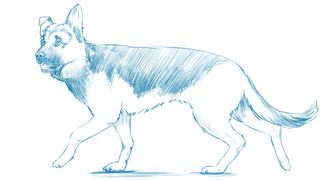
Today's tutorial will bear witness you how to draw a domestic dog. The skeletons of dogs and cats are quite like, particularly in the simplified version fatigued here. But it'south of import to remember that these animals move differently and await very different from each other.
This tutorial will have you through the step-by-step process of how to draw a dog. We will exist sketching an anatomically correct portrait of a German Shepherd. This will get-go with sketches and move on to drawing the skeleton, muscles and fur. By the end, yous'll be drawing a dog with ease. For more than advice, take a look at our roundup of tutorials exploring how to draw animals.
01. Observe in quick sketches
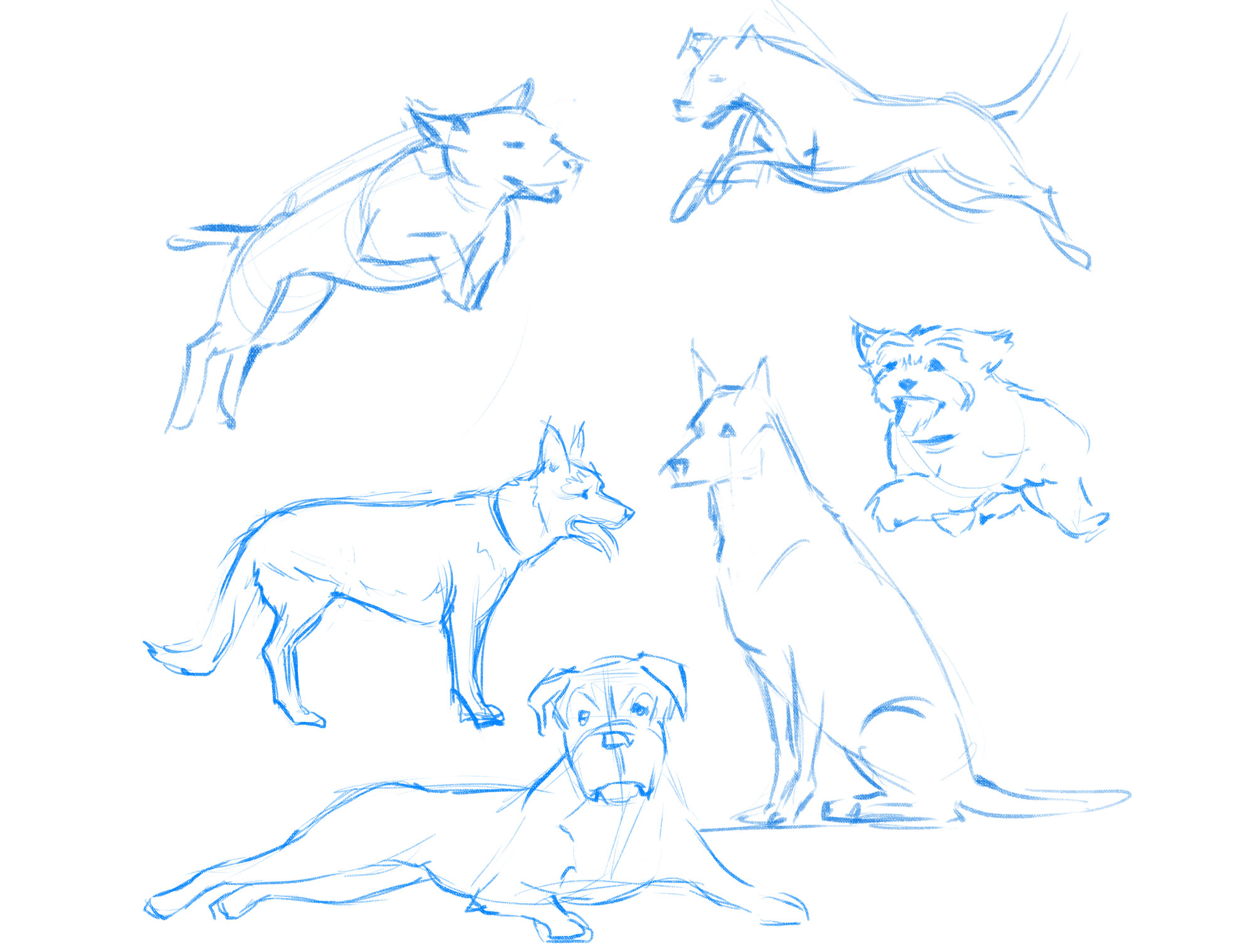
Many people – specially those who are new to art – disregard the sketching phase and consider it a waste material of time. Ofttimes they will draw one or ii sketches and telephone call it a day. It'southward very piece of cake to exist tempted to speed up this stage. Subsequently all, details are much more fun to draw, aren't they?
The problem is, if nosotros're too eager to get to the details, information technology'due south like shooting fish in a barrel to ignore the overall beefcake. And trust me on this: beautifully rendered fur on a creature that simply partially resembles a canis familiaris volition print no one.
If yous ain a dog yourself, observe how they walk, run, jump, sit or lie downwards. You lot may recall you lot know how they move, just you really won't until you consciously notice the animal. You can too google some photos of dogs and use them as reference to apace sketch different poses. Attempt not to spend time on details – the sketching phase is not well-nigh that.
02. Discover the skeleton
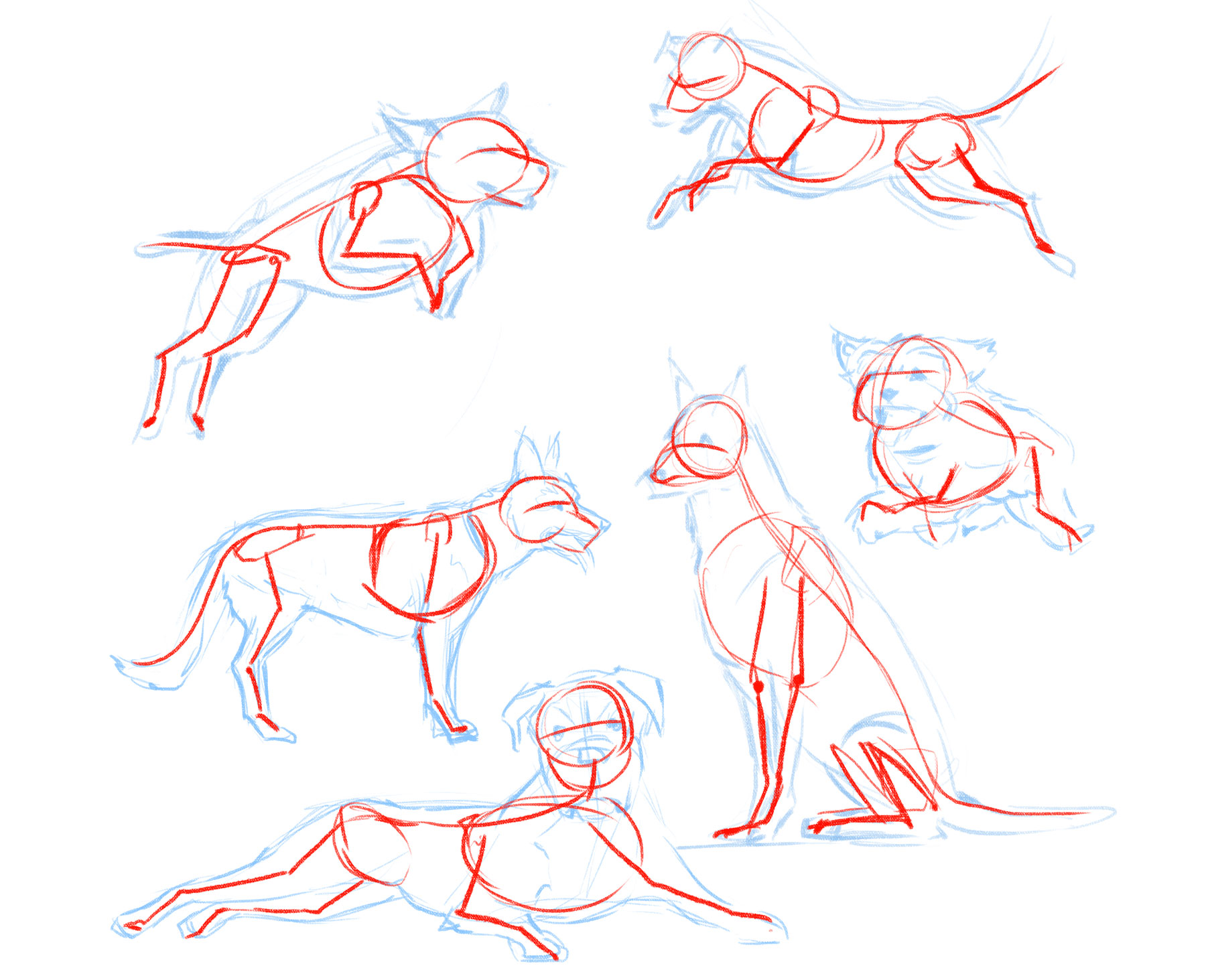
Focusing on the skeleton is a central part of mastering how to depict a dog. Even though in the end no one is going to see information technology, it'south essential to understand the skeleton and be able to draw it in proportion. Every bit you go more proficient you may start drawing the skeleton more loosely or perchance even exist able to skip this pace altogether because by then the proportions will be engraved in your retention.
Earlier you movement on to cartoon the skeleton in your called pose, a good practice would exist to depict the construction on top of your previous quick sketches. This will help y'all become more familiar with the idea of a skeleton underneath all that cute fur that dogs are covered in.
03. Describe the skeleton
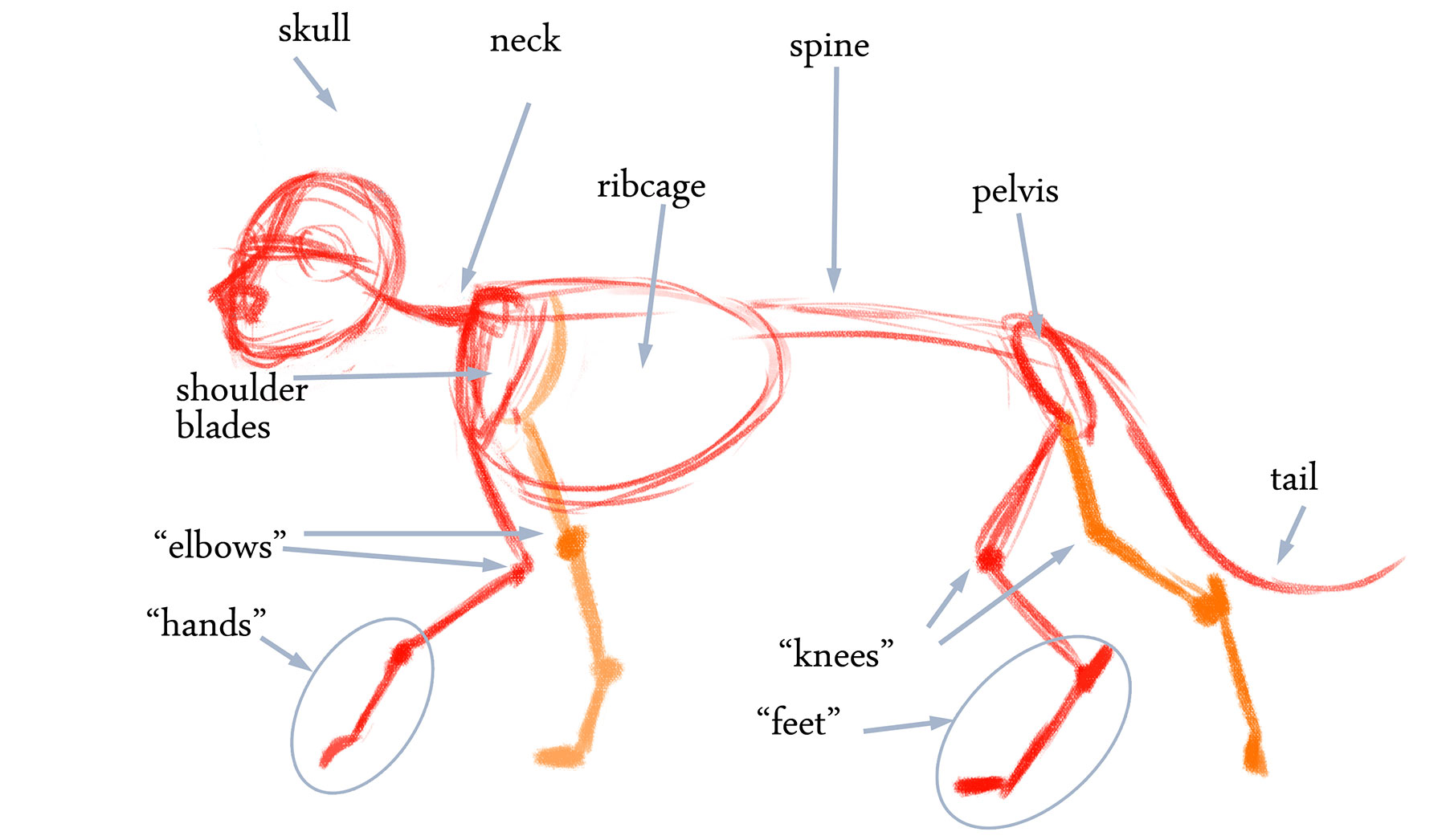
As you sketch dogs in different positions you lot will soon realise which one appeals to y'all the virtually. Perhaps you'll cull to draw a domestic dog napping, or sitting. This tutorial will apply a walking pose as this shows the animal and its anatomy in the all-time possible way.
Loosely draw the skeleton of a dog in your called pose. A good tip is to draw the skull, ribcage and pelvis bone, and use single lines to indicate the spine, tail and limbs.
Dogs' skeletons have many similarities with human skeletons. Yous can clearly see the equivalent of human being knees, elbows, feet and hands. Dogs' legs are not that dissimilar from our arms and legs – the just existent difference is in the proportions of the bones.
If y'all look closely you'll run into that dogs walk on the balls and toes of their feet, sort of like a adult female in high heels. Notice how opposing front and back legs carrying virtually of the weight of the dog. They are firmly placed on the footing, while the other two barely touch the flooring.
If you work in traditional media, utilise very light strokes for the skeleton, then that you can erase it later. If you work digitally, depict each step on a separate layer.
04. Depict in the muscles

The point of this step is to plant the anatomy beneath all the fur. High german Shepherds are non particularly fluffy, so the muscles will be visible through the outer coat. However, if yous choose a brood such equally an Afghan Hound or Bernese Mountain Domestic dog you lot'll face a slightly bigger claiming finding the muscles nether all the fur.
It is important to sympathise how the muscles sit nether the skin. Understanding the general rules will requite y'all the tools you need to describe any dog, regardless of the pilus length.
05. Focus on the face
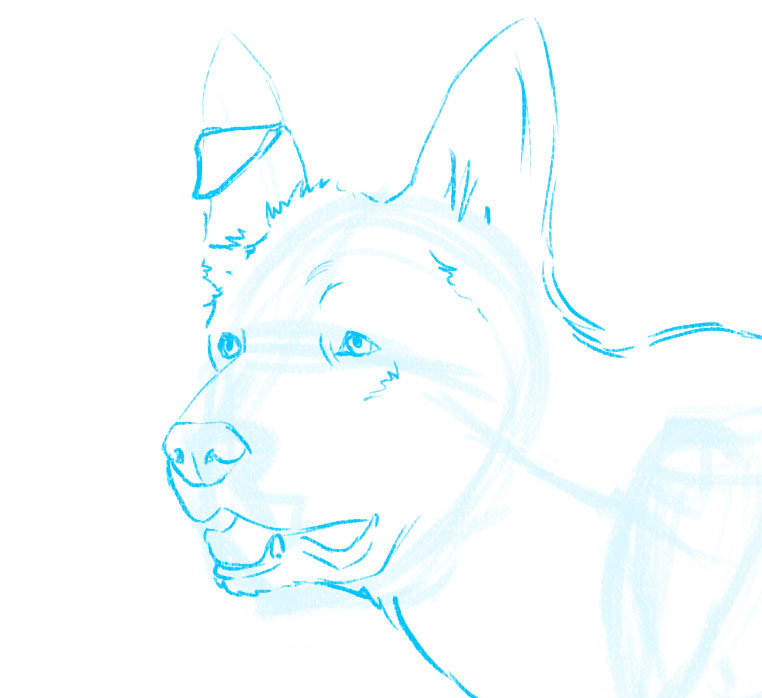
Now it's time to refine the drawing, beginning with the caput. Nosotros desire to start using stronger, more decisive lines at this point.
Information technology's very important to observe the correct position of the optics. If you're drawing a dog's head straight-on, it's adequately like shooting fish in a barrel to maintain the correct proportions between the eyes and olfactory organ. Yet, drawing the face in a slightly turned view tin can exist much trickier. Not just are the eyes at present at a different angle, which changes their shape and size, but their position in relation to the nose also changes.
It's of import to remember that the eye that is farther away from the viewer will not be the same size as the one in the foreground. Perspective means the closer eye will exist slightly bigger.
06. Draw in the muzzle
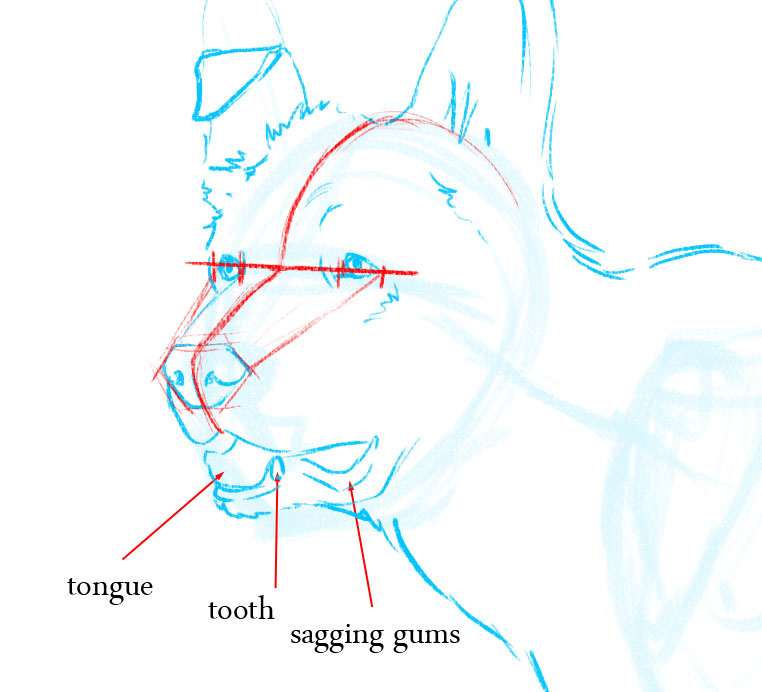
Like many other dogs, German Shepherds have quite long muzzles. Even pugs, which don't have prominent muzzles, don't accept entirely flat faces. The length of the dog's muzzle will vary depending on its breed, then make sure to observe this advisedly.
Making the muzzle too long or likewise brusque volition drastically alter the likeness of the dog. Call back that in a 3-quarter view, the muzzle will announced shorter.
Pay close attention to the shape and size of the nose as well. Most canis familiaris'due south noses look quite like, simply depending on the breed they can be bigger or smaller in relation to the rest of the head. If the canis familiaris has an open mouth they will ordinarily show their teeth, gums and tongue, which is typically quite long and flexible.
07. Move on to the ears

Every bit with the eyes, it is necessary to pay close attention to perspective when drawing ears. Observe the shape of the head and how the ears are fastened to information technology. The ears are generally a mirror paradigm of each other, but even when painting uneven ears (some dogs have ane droopy ear, for example) they volition stay a consistent shape at their base of operations. In this case one of the ears has been altered on purpose as an example
08. Refine the torso

We already have a adept thought of the musculature of the body, but on top of the muscles there is skin and fur. In some cases this can drastically change the await of the domestic dog (remember nearly how unlike certain dogs can await afterwards they've been groomed).
German Shepherds are nonetheless hairy in places, so where necessary employ smaller strokes to indicate fur. The dog we're drawing has thicker fur effectually its neck, under its abdomen and on its tail, but on the residue of his body, especially the head and legs, his hair is shorter. Avoid using the same kind of strokes all over unless information technology's a brusk-haired brood.
When yous're done, erase the underlying lines if working traditionally or turn off the skeleton/musculus layers if you're working digitally.
09. Consider fur patterns

Every domestic dog is a little unlike, and their colours can vary greatly. This can still exist shown even in a black-and-white sketch. Use varying pencil strokes when shading to ensure the coat blueprint doesn't look flat.
This dog's hair is mainly brownish and black. Information technology'south not necessary to recreate all of the tonal values, so instead you could sketch in only the black parts of the fur. A proficient tip is to use lighter strokes along the dog's back to indicate a light source hitting the fur.
10. Add together final touches

Finally, add some subtle strokes along the canis familiaris'south legs to give a suggestion of muscles showing underneath the fur. The idea is to convey enough information to requite the dog character without having to shade the entire silhouette. The last bear on is to add some shadows under the paws and voilà – you drew a domestic dog!
If you want to learn more, you could check out how to describe a pencil portrait of a domestic dog or discover a guide to drawing a dog'south muscle groups.
Read more:
- The all-time pencils for colouring, drawing and sketching
- How to draw: The best drawing tutorials
- The 12 best drawing books
Related articles
horrocksvinswasander1941.blogspot.com
Source: https://www.creativebloq.com/how-to/draw-a-dog
0 Response to "How to Draw a Dog Body Sitting"
Post a Comment